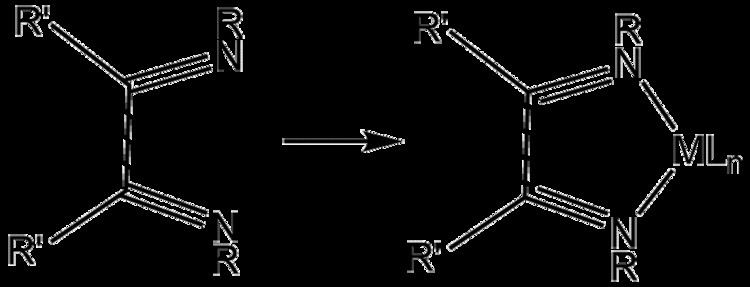 | ||
Diimines are organic compounds containing two imine (RCH=NR') groups. The most popular derivatives are 1,2-diketones and 1,3-diimines. These compounds are used as ligands and as precursors to heterocycles. Diimines are prepared by condensation reactions where a dialdehyde or diketone is treated with amine and water is eliminated. Similar methods are used to prepare Schiff bases and oximes.
Contents
1,2-Diimines
The 1,2-diketimine ligands, also called α-diimines, include dimethylglyoxime as well as oxidized derivatives of o-phenylenediamine. The steric properties of the substituents on nitrogen provide a means to control the axial coordination sites on a square planar complex. Large planar substituents such as mesityl tend to be orthogonal to the MN2 plane. In this way, the axial coordination sites on a square planar complex are shielded. Such steric control is not possible for complexes of the related to 2,2'-bipyridine, glyoximate, and 9,10-phenanthroline ligands.
An example is glyoxal-bis(mesitylimine), a yellow solid that is synthesized by condensation of 2,4,6-trimethylaniline and glyoxal.
1,2-Diketimines, but not the 1,3-diketimines, are “non-innocent ligands”, akin to the dithiolenes.
1,3-Diimines
For example, acetylacetone (2,4-pentanedione) and a primary alkyl- or arylamine will react, typically in acidified ethanol, to form a diketimine. 1,3-Diketimines are often referred to as HNacNac, a modification of the abbreviation Hacac for the conjugate acid of acetylacetone. These species form anionic bidentate anionic ligands.
Uses
Substituted α-diimine ligands are useful in the preparation of so-called post-metallocene catalysts for the polymerization and copolymerization of ethylene and alkenes.
Diimines are precursors to NHC ligands by condensation with formaldehyde.
